April 21, 2017
Early Blooming Spring Perennials
Who isn’t excited by the first green shoots brave enough to poke their snouts out of the soil at winter’s end? Nothing lifts our spirits like the first blooms of spring. Imagine flowers in March, April and May while you wait for the glory of summer to come. Here are some easy care early bloomers that once planted, will delight you every spring for years to come. In addition to their flowers, these plants offer interesting foliage, bringing texture and color to the garden throughout the growing season. Get a jump start on the flowering season in your garden!
Helleborus (Hellebore)
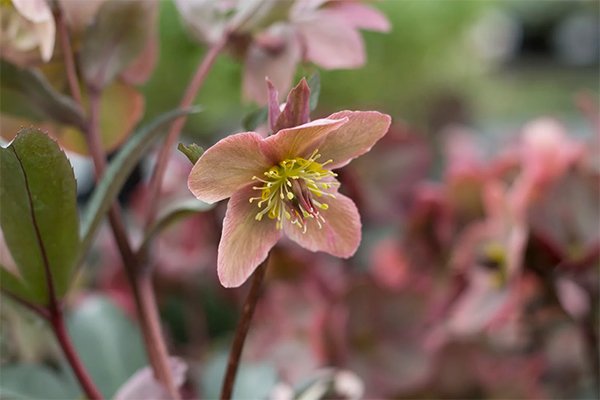 Hellebores thrive in rich, well-drained soil in part-sun or dappled shade. The species Helleborus niger (also known as the Christmas rose) is the earliest to bloom, with flowers appearing as early as February/March. The species Helleborus orientalis, or Lenten Rose, has been used in breeding efforts, resulting in the beautiful hybrids we know today. Plants are clump forming with thick evergreen hand-shaped leaves. In late winter the flower spike tops the leaves, branching out to produce a cluster of silver-dollar sized flowers. Each flower remains in bloom for 3 months or more. We use the term “flower” loosely as the flower is actually a modified calyx and it is this feature that accounts for such a long period of bloom.
Hellebores thrive in rich, well-drained soil in part-sun or dappled shade. The species Helleborus niger (also known as the Christmas rose) is the earliest to bloom, with flowers appearing as early as February/March. The species Helleborus orientalis, or Lenten Rose, has been used in breeding efforts, resulting in the beautiful hybrids we know today. Plants are clump forming with thick evergreen hand-shaped leaves. In late winter the flower spike tops the leaves, branching out to produce a cluster of silver-dollar sized flowers. Each flower remains in bloom for 3 months or more. We use the term “flower” loosely as the flower is actually a modified calyx and it is this feature that accounts for such a long period of bloom.
But putting the botanical nomenclature to the side, it is the flower colors of the Helleborus hybrids that enthrall. They range from black-purple to red-purple, to pink, to white and even yellow. Many have speckles of different colors in the center and at the edge of the flowers. Varieties such as ‘Pink Frost’ and ‘Love Bug’ are just a few of the many choices you will find. While hellebore foliage remains evergreen, some leaves may be damaged by harsh winter conditions. We suggest waiting to remove the old foliage until just before the flowers emerge. As you are enjoying the long blooming period, the plant will push new foliage with warming temperatures. Hellebores have the added benefit of being deer resistant.
Pulmonaria (Lungwart)
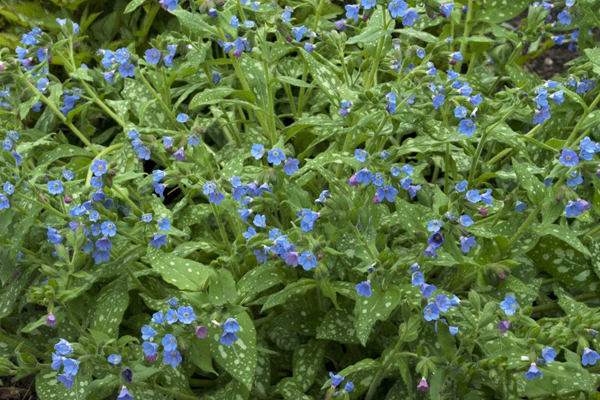 Pulmonarias are a wonder in the woodland garden and can be counted on to bloom soon after the Hellebores. Flowers appear in profuse clusters that can be blue, pink or white, and frequently two or more colors will be found on a single plant. The flowers often start out one color and fade into another color as the flower ages. The whole effect is lovely. A distinctive feature of Pulmonaria is its foliage: rich green with silver spots. Recent introductions have predominantly silver leaves that shimmer in a shady setting. Plants grow approximately 9 to 12 inches tall and will spread to two feet. They perform best in shady, moist soil that is rich in organic matter. ‘Raspberry Splash’, ‘Mrs. Moon’ and ‘Trevi Fountain’ are just three varieties of this charming and hardy plant. And like the Hellebores, Pulmonarias are deer resistant.
Pulmonarias are a wonder in the woodland garden and can be counted on to bloom soon after the Hellebores. Flowers appear in profuse clusters that can be blue, pink or white, and frequently two or more colors will be found on a single plant. The flowers often start out one color and fade into another color as the flower ages. The whole effect is lovely. A distinctive feature of Pulmonaria is its foliage: rich green with silver spots. Recent introductions have predominantly silver leaves that shimmer in a shady setting. Plants grow approximately 9 to 12 inches tall and will spread to two feet. They perform best in shady, moist soil that is rich in organic matter. ‘Raspberry Splash’, ‘Mrs. Moon’ and ‘Trevi Fountain’ are just three varieties of this charming and hardy plant. And like the Hellebores, Pulmonarias are deer resistant.
Brunnera macrophylla
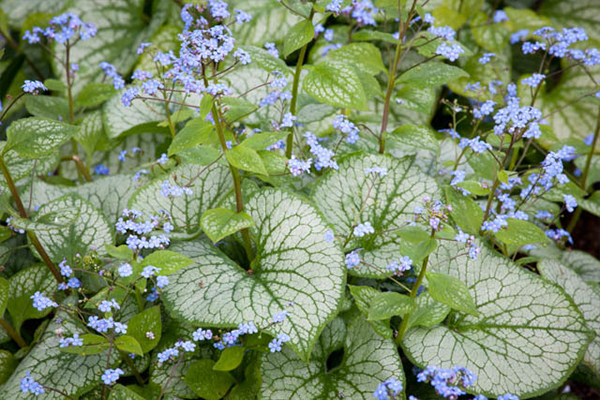 Brunnera is considered by many plant aficionados to be one of the most attractive plants for the shade garden. A clump forming plant, its foliage has a rich green base overlaid with a silver crackle finish. The baby blue flowers appear in early to mid-spring and resemble forget-me-nots.
Brunnera is considered by many plant aficionados to be one of the most attractive plants for the shade garden. A clump forming plant, its foliage has a rich green base overlaid with a silver crackle finish. The baby blue flowers appear in early to mid-spring and resemble forget-me-nots.
Brunnera prefers moist conditions and soil that is rich in organic matter. A mature plant reaches 12 to 18 inches in height and up to 2 feet in width. Wonderful new varieties have become available in the last few years. ‘Jack Frost’ was named Perennial Plant of the Year in 2012. The leaves of ‘Looking Glass’ are almost solid silver. ‘Silver Heart’ forms a clump of very thick, heart-shaped leaves that are a shimmery silver with green edging and veining. No matter the variety, people never fail to stop and ask about Brunnera when they see it in a garden.
Dicentra (Bleeding Heart)
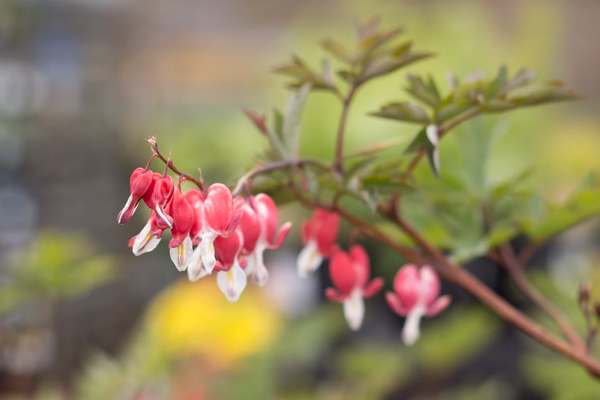 Truly a classic, old fashioned Bleeding Heart, Dicentra spectabilis remains an essential plant in any garden. Its light green foliage is deeply cut and lobed, and its stems are fleshy. Flowers appear in chains of puffy pink petals with white tips. They dangle from stems that stand above the foliage. A mature plant will be 2 to 3 feet tall and as wide. It is also available in a white flowering form, Dicentra spectabilis ‘Alba’. A relatively new variety, ‘Valentine’ offers the same charms as the species but with arching spikes of elegant cherry-red, heart-shaped blooms with white tips held on dark burgundy stems.
Truly a classic, old fashioned Bleeding Heart, Dicentra spectabilis remains an essential plant in any garden. Its light green foliage is deeply cut and lobed, and its stems are fleshy. Flowers appear in chains of puffy pink petals with white tips. They dangle from stems that stand above the foliage. A mature plant will be 2 to 3 feet tall and as wide. It is also available in a white flowering form, Dicentra spectabilis ‘Alba’. A relatively new variety, ‘Valentine’ offers the same charms as the species but with arching spikes of elegant cherry-red, heart-shaped blooms with white tips held on dark burgundy stems.
Dicentra eximia (Fringed Bleeding Heart) is a shorter growing species with blue-green foliage that is deeply cut and fern-like. Flowers are rose pink to red. It is native to the eastern United States. A west coast native, Dicentra formosa is similar to Dicentra eximia. It has narrower flowers and longer, more curved outer petal tips. Dicentra formosa ‘Luxuriant’ and ‘King of Hearts’ are especially attractive cultivars.
Aquilegia (Columbine)
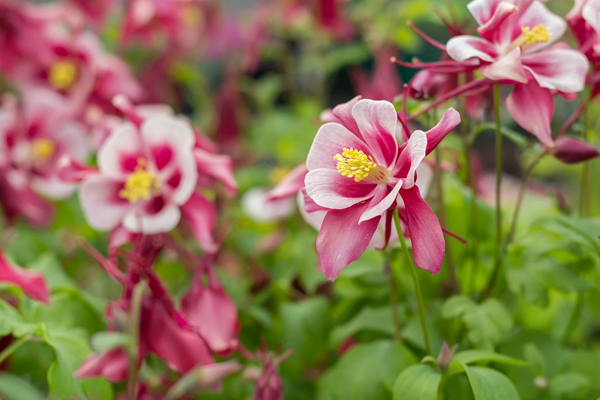 Aquilegia plants have an airy appearance, with small, rounded leaves and tall flower stalks that hold bellshaped blooms above the foliage. Each flower has 5 petals that flare out from the base, surrounded by a collar of 5 larger sepals. The long, nectar holding spurs arch backward out of the flowers, making the flowers popular with hummingbirds and bees. Petals and sepals come in a variety of colors and combinations, in shades of light blue, pink, purple, red, white and yellow. Aquilegias relish dappled shade and love deep, rich soil.
Aquilegia plants have an airy appearance, with small, rounded leaves and tall flower stalks that hold bellshaped blooms above the foliage. Each flower has 5 petals that flare out from the base, surrounded by a collar of 5 larger sepals. The long, nectar holding spurs arch backward out of the flowers, making the flowers popular with hummingbirds and bees. Petals and sepals come in a variety of colors and combinations, in shades of light blue, pink, purple, red, white and yellow. Aquilegias relish dappled shade and love deep, rich soil.
Columbines have a reputation for going dormant in the summer but if kept watered after flowering, the elegant foliage will last into the fall. The Swan Series offers a lovely range of colored flowers with long-spurs. Some varieties in the series are solid colored, while others are bi-colored. Stunning in the garden! Here’s an interesting note: the name Aquilegia comes from the Latin word for eagle, in reference to the flower’s five spurs which purportedly resemble an eagle’s talon.
Come in to any of our 7 locations and get your early blooming perennials today! Or you can check out our selection on our online store. Happy shopping!
